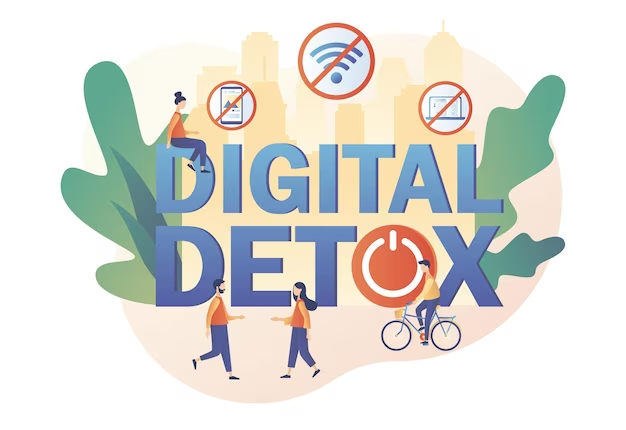Digital Detox: How to Find Balance in a Hyper-Connected World

In today’s world, we are more connected than ever. From smartphones that rarely leave our hands to endless notifications from social media, emails, and apps, it’s easy to feel overwhelmed. While technology has brought us closer, it’s also made it harder to disconnect. This is where a digital detox comes in — a conscious break from technology to restore balance, reduce stress, and improve mental well-being.
What Is a Digital Detox?
A digital detox refers to intentionally reducing or eliminating the use of digital devices, including smartphones, computers, tablets, and social media platforms, for a specific period. The goal is to reconnect with the physical world, recharge mentally, and create a healthier relationship with technology.
Why Is a Digital Detox Important?
- Mental Health Benefits
Constant exposure to digital content can lead to stress, anxiety, and information overload. Social media can also contribute to feelings of inadequacy or low self-esteem, as we compare ourselves to the highlights of others’ lives. A detox allows the mind to rest and reduces anxiety. - Improved Focus and Productivity
Being bombarded with notifications and distractions limits our ability to focus on important tasks. Stepping away from digital devices can enhance concentration and productivity by removing distractions. - Better Sleep
The blue light emitted by screens can interfere with sleep by disrupting the production of melatonin, the hormone that regulates sleep. Reducing screen time, especially before bed, can improve sleep quality. - More Meaningful Interactions
Spending less time on digital devices gives you more opportunities to connect with others in real life. Whether it’s family dinners, conversations with friends, or simply being present in social situations, a digital detox enhances real-world connections.
Signs You Need a Digital Detox
- You feel anxious when you’re not near your phone.
- You constantly check notifications, even when there aren’t any.
- You find yourself mindlessly scrolling through social media for hours.
- You struggle to focus on tasks without being distracted by your phone.
- You experience “phantom vibrations” — thinking your phone is buzzing when it’s not.
If any of these sound familiar, it may be time for a digital detox.
How to Do a Digital Detox
- Set Clear Boundaries
- Define how long you want your detox to last — it could be for a few hours a day, an entire weekend, or even a week. Decide in advance what you’ll restrict, such as social media apps or smartphone usage.
- Schedule “Screen-Free” Time
- Dedicate specific periods of your day to being screen-free. For example, establish a rule that there will be no phones during meals, before bed, or during family time.
- Turn Off Notifications
- Disable non-essential notifications to prevent constant interruptions. This helps you focus on real-world activities without being distracted by your phone.
- Use Analog Alternatives
- Instead of reading the news on your phone, pick up a physical newspaper or book. Instead of using digital notes, try using a pen and paper to jot down ideas. These small changes can give you a much-needed break from screens.
- Create Tech-Free Zones
- Designate certain areas in your home as tech-free, such as the bedroom or dining room. This encourages you to be more present and helps reduce your reliance on digital devices.
- Replace Screen Time with Offline Activities
- Fill the time you’d normally spend on your devices with offline activities like reading, exercising, or spending time in nature. This helps reinforce healthier habits and prevents boredom.
- Practice Mindfulness
- Engage in mindfulness activities such as meditation or yoga to calm the mind and reduce stress. These activities can help you stay grounded and focus on the present moment.
Tips for Maintaining Balance After a Detox
- Limit Social Media Usage
After your detox, consider setting daily limits for social media apps. Many phones now offer features that track and limit screen time, making it easier to stay on track. - Practice Digital Minimalism
Evaluate which apps, platforms, and technologies add value to your life and which don’t. By minimizing unnecessary digital clutter, you can create a healthier and more intentional digital experience. - Regularly Unplug
Incorporate regular digital detox periods into your routine. Whether it’s a few hours each week or a tech-free weekend each month, scheduling breaks from technology can help maintain a healthy balance. - Reconnect with Hobbies
Use the time freed up from your devices to rediscover hobbies or passions you’ve neglected. Painting, reading, hiking, or cooking can provide joy and fulfillment outside of the digital world.
Conclusion
In a hyper-connected world, finding balance between our digital lives and real-world experiences is essential for mental health, productivity, and overall well-being. A digital detox offers a refreshing way to reclaim control over your time, reduce stress, and focus on what truly matters. By setting clear boundaries and incorporating offline activities, you can create a more intentional and fulfilling relationship with technology.
So, when was the last time you unplugged? Maybe it’s time to give your mind a break and rediscover life without constant digital distractions.


